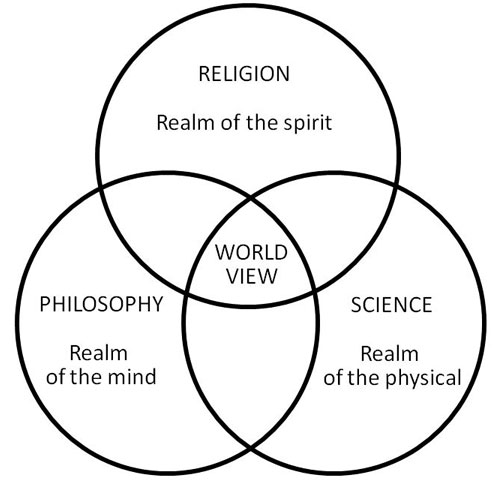The relationship between religion and science has been a subject of study since Classical antiquity. It has been addressed by philosophers, theologians, scientists, and other commentators. Some contemporary scientists are of the opinion that religion and science are non-overlapping magisterial, addressing fundamentally separate forms of knowledge and aspects of life. Some theologians or historians of science, propose an interconnection between them. In my readings I have found authors and concepts addressing the overlapping of science, religion and philosophy that I find detrimental for understanding that we are here to improve ourselves and that we are all connected.
James N. Gardner, a complexity theorist and essayist, wrote in his book Biocosm: The New Scientific Theory of Evolution: Intelligent Life is the Architect of the Universe, that the “overlapping domains of science, religion, and philosophy should be regarded as virtual rain forests of cross-pollinating ideas” and that “the messy science/religion/philosophy interface should be treasured as an incredibly fruitful cornucopia of creative ideas”.
This idea of overlap is addressed in Theosophy, where the second objective is “To encourage the study of comparative religion, philosophy, and science.” In the Theosophical view religion, science and philosophy are three different approaches to the truth and when rightly followed are not contradictory. In fact they blend into one another. They are three ways of viewing the truth of the universe, and what at one time is religion or philosophy will be science at another time. As a British scientist, John D. Barrow, has written (Theories of Everything, 4):
“Today, physicists accept the atomistic viewpoint that material bodies are at root composed of identical elementary particles, as [that view is] well supported by evidence. It is taught in every university in the world. Yet, this theory of physics began amongst the early Greeks as a philosophical, or even mystical, religion without any supporting observational evidence whatsover… Atomism began life as a philosophical idea that would fail virtually every contemporary test of what should be regarded as “scientific”; yet, eventually, it became the cornerstone of physical science. One suspects that there are ideas of similar groundless status by today’s standards that will in the future take their place within the accepted “scientific” picture of reality.”
Carter Phipps refers in his book “Evolutionaries: Unlocking the Spiritual and Conscious” to Jean Gebser when he explains that there is “evidence that integrative, cross-disciplinary thinking may not be the latest and greatest idea of the cognoscenti but an actual higher mental function that represents a further step in the evolution of consciousness itself.”
Gebser describes in his monumental work The Ever-Present Origin consciousness as “being present”. His major thesis was that human consciousness is in transition, and that these transitions are mutations and not continuous (compare with Initiation by Elisabeth Haich). Looking back into our human past he distinguished four levels of consciousness: the archaic structure, the magical structure, the mythical structure, and the mental structure. Working from the historical evidence of almost every major field including religion, physics, philosophy and natural sciences Jean Gebser saw traces of the emergence (which he called “efficiency”) and collapse (“deficiency”) of various structures of consciousness throughout.
Gebser saw through the quagmire of “the decline of the West” the emergence of a new structure of consciousness, the integral structure. This structure requires our conscious effort through personal and collective self-transcending practice. In the chapter about integral consciousness of his book he writes in this context, that the necessary changes in humanity won’t be reached through attempts of making the world a better place. In his opinion those so-called “do-gooders” are shirking their responsibility to work on and improve themselves. They are playing the game of demanding from others what they are too lazy to do themselves. In his words they are not only betraying themselves but the whole world.
In the same book he explains in the article “Dualismus und Polarität” [dualism and polarity] how the classical view of “either and or” (dualism) which has been valid for thousand of years has to be substituted with the view of “as well as” (polarity). Based on the scientific discoveries of Max Planck, Albert Einstein, Ernest Rutherford, Niels Bohr and Werner Heisenberg about Quantum Physics and the Theory of Relativity we can’t avoid to change our way of thinking. We must integrate these new concepts into our way of live. With these discoveries our model of the universe expanded rapidly and advanced theoretical physics demonstrated that everything in the universe is subtly dependent upon everything else.
Whereas in dualism opposite views were irreconcilable (e.g. good and bad; the here and now and the afterlife; fear and hope; beautiful and ugly), in polarity you understand that everything is interdepend and can’t fight each other with impunity or exclude each other (e.g. male and female principles; employer and employee). These “poles” are dependent on each other and build a whole (Yin and Yang).
